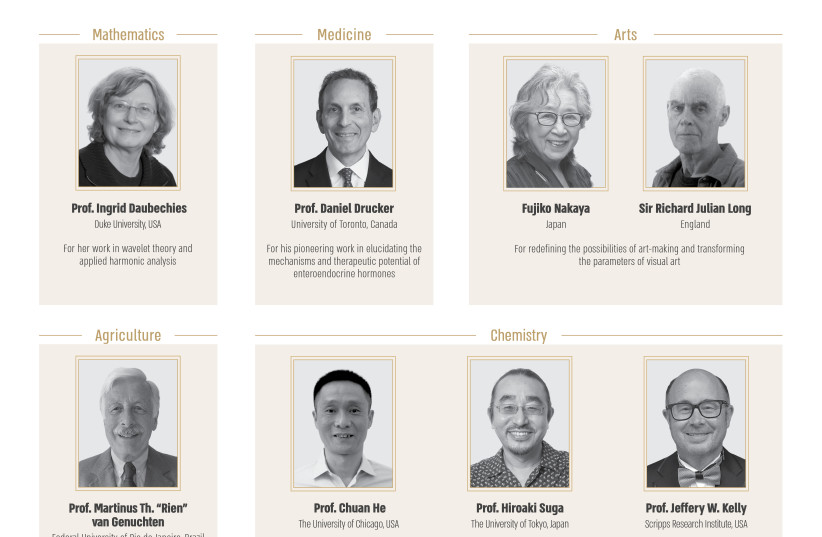Names of winners of this year’s Wolf Prize, regarded as “Israel’s Nobel Prize” or a predictor of who will receive Nobel Prizes in the future – have been announced. They include eight outstanding scientists and artists from abroad, who will receive their award from President Isaac Herzog in the Knesset in May.
The Wolf Foundation was founded in 1975 by inventor, diplomat, and philanthropist, the late Dr. Ricardo Wolf, and his wife, who donated their own capital to establish the foundation which they co-founded with former Israeli president Ephraim Katzir and prime minister Yitzhak Rabin.
Among hundreds of foreign and Israeli laureates over the years were scientists Prof. Stephen Hawking, Prof. Dan Shechtman, Prof. Ada Yonath; conductors Zubin Mehta, and Daniel Barenboim; violinist Isaac Stern, opera singer Jessye Norman; architects Frank Gehry, Moshe Safdie, and Elizabeth Diller; artists Marc Chagall, Anselm Kiefer, Louise Bourjois, Laurie Anderson, Cindy Sherman and many more.
Since the foundation was founded, 373 scientists and artists have been recognized; about a third of the Wolf Prize Laureates subsequently received the Nobel Prize in the areas common to the two prizes.
Every year, the President of Israel awards the prestigious prize to scientists and artists from around the World - for achievements “in advancing science and art for humanity and for friendship between peoples, regardless of race, religion, gender, geographical location or political view.” The laureates are selected by international jury committees, which are appointed each year and include professionals, world-renowned in their field.


Repeat winners
The acclaimed Wolf Prize has gained a prestigious international reputation and has been awarded for the 45th year. Only in 2022, five Nobel laureates have previously won the Wolf Prize: Professors Caroline Bertozzi; Karl Barry Sharpless; Alain Aspect; John Clouser, and Anton Zeilinger. In past years, among the Wolf Prize winners who also won the Nobel Prize were professors Giorgio Parisi; Emmanuel Charpentier; Jennifer Doudna; Michelle Mayor; Didier Queloz, and James Ellison.
Among 2023’s laureates are the endocrinologist who laid the foundation for the production of innovative hormone-based drugs to treat diabetes and obesity; the mathematician who revolutionized the world of mathematics and paved the way for technological innovations in the worlds of digital cinema and medical imaging; the researchers who developed strategies for using biopolymers to eradicate diseases; the researcher whose models he built for water flow and predicting contaminant transport in soils helps agriculture around the world; and the artist who ignores fixed paradigms creates a new life for earth, snow, and fog and brings together in their creation the worlds of nature, poetry, technology, and science.
The prizes were awarded this year to laureates from five different countries: US, Canada, Brazil, Japan, and the UK. The winners will attend the award ceremony, which will be held in June 2023 at the Knesset of Israel.
The Wolf Prize in Medicine for 2023 is awarded to Prof. Daniel Drucker, University of Toronto, Canada for pioneering work in elucidating the mechanisms and therapeutic potential of enteroendocrine hormones.
He made seminal contributions to the understanding of the physiology and pharmacology of glucagon-like peptides (GLPs) and their use for the benefit of patients. His discoveries of GLP-1, GLP-2, and dipeptidyl peptidase-4 (DPP-4) activity have enabled the development of multiple new innovative classes of medications for the treatment of diabetes, obesity, and obesity-associated comorbidities. He demonstrated that GLP-1 directly stimulates insulin secretion from pancreatic beta cells.
The Wolf Prize in Mathematics is awarded to Prof. Ingrid Daubechies of Duke University in North Carolina for work in wavelet theory, applied harmonic analysis and modern time-frequency analysis. Her work is of tremendous importance in image compression, medical imaging, remote sensing, and digital photography. Daubechies has also made unparalleled contributions to developing real-world applications of harmonic analysis, introducing sophisticated image-processing techniques to fields ranging from art to evolutionary biology and beyond.
The Wavelet theory, as presented by the work of Professor Daubechies, has become a crucial tool in many areas of signal and image processing. For example, it has been used to detect forged documents and fingerprints. Wavelets are a vital component of wireless communication and are used to compress sound sequences into MP3 files.


The Wolf Prize in Chemistry is jointly awarded to Profs. Chuan He, Jeffery Kelly, and Hiroaki Suga for pioneering discoveries that illuminate the functions and pathological dysfunctions of RNA and proteins and for creating strategies to harness the capabilities of these biopolymers in new ways to ameliorate human diseases.
He of the University of Chicago discovered reversible RNA methylation and its role in the regulation of gene expression. More than 150 structurally distinct post-transcriptional modifications of cellular RNA molecules occur at thousands of sites. He has done pioneering work elucidating the chemistry and functional consequences of RNA modification.
Suga of the University of Tokyo receives his award is awarded to Hiroaki Suga for developing RNA-based catalysts that revolutionized the discovery of bioactive peptides. Suga used tools of bioorganic chemistry, chemical biology, and biotechnology related to RNA, translation, and peptides and developed a platform for producing and selecting billions of macrocyclic peptides as high-affinity binders to disrupt protein-protein interactions.
Kelly of Scripps Research Institute in San Diego, California developed a clinical strategy to ameliorate pathological protein aggregation.
Most protein molecules must fold into defined three-dimensional structures to function properly. Misfolded proteins can form toxic aggregates, such as fibrillar amyloid deposits, which may lead to neurodegeneration in Alzheimer's disease and many other pathologies. He contributed significantly to the fight against neurodegenerative diseases by discovering the mechanism of protein aggregation in amyloid diseases that affect the heart and nervous system.
The Wolf Prize in Agriculture is awarded to Prof. Martinus Th. “Rien” van Genuchten at the Federal University of Rio de Janeiro, Brazil for his groundbreaking work in understanding water flow and predicting contaminant transport in soils.
The vadose zone is the undersaturated portion of the subsurface that lies above the groundwater table. The soil and rock in the vadose zone are not fully saturated with water; that is, the pores within them contain air as well as water. Water movement within the vadose zone is important to agriculture, flood control, cultivation of plants, construction of buildings, disposal of waste, and for determining the amount and quality of groundwater available for human use. He transformed the broad fields of soil physics and vadose zone hydrology.
He created a much-needed scientific basis for understanding fluid flow and contaminant transport processes in unsaturated soils, including their interactions with the atmosphere above and groundwater below.
The Wolf Prize in Art is jointly awarded to Fujiko Nakaya and Richard Long for redefining the possibilities of art-making and transforming the parameters of visual art. Nakaya, one of Japan’s leading artists. os a longtime pioneer of work that intermingles the realms of art, nature, science, and technology.
Her sculptures, films and videos, installations, and paintings produced over a seven-decade career engage fundamental subjects such as the environment, perception, and communication. Half a century after she first developed the concept of fog sculptures, she continues to astonish audiences with the magic of work made at the junction of art and nature, poetry and science.
Long is a pioneer of conceptual art centered on personal interaction with the natural world. Over the course of nearly six decades, his solitary walks throughout the world have generated a complex body of work comprising sculptures, photographs, and drawings that are nature-based: rocks and stones, logs and twigs, mud and soil.
